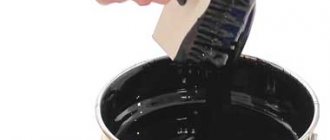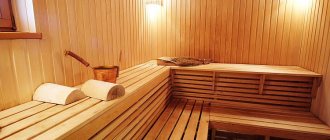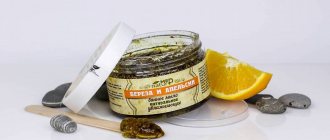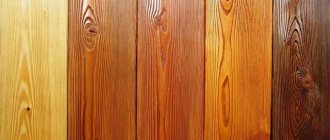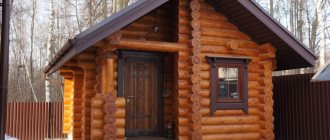Features of wax impregnation for baths
Impregnation of wooden surfaces with wax is called waxing and has been popular for many years due to its distinctive properties:
- Versatility
. Suitable for processing all wooden elements in the steam room and auxiliary rooms. - Environmental friendliness
. Does not emit toxic substances under the influence of high temperatures. - Safety
. Does not heat up or burn the skin. - Biosecurity
. Prevents the appearance of small insects, which is especially important if the bathhouse is not used often. - Moisture protection
. Thanks to this, the wood does not crack, is not affected by mold and mildew, and at the same time “breathes.” - Conservation of original appearance
. The wood does not lose color and structure, becomes pleasant to the touch and acquires a honey tint. In addition, waxing sauna shelves protects them from scratches. - Hypoallergenic
. Due to its natural origin, it does not cause discomfort to allergy sufferers. - Simplicity and efficiency of processing
. The impregnation process can be carried out independently, and the steam room will be ready for use the very next day. - Keeping the surface clean
. Caring for wood is easy because it does not absorb dirt.
The ceiling, walls, floors in the steam room and washing room, as well as shelves are treated with different compounds.
For steam room shelves, wax is the most popular. It does not create a film on the surface, and therefore does not burn the body at high temperatures. This is its main difference from compositions for walls and ceilings, as well as for auxiliary rooms. Wax is successfully used to impregnate the floor in a steam room because it does not make the coating slippery, which is very important in conditions of high humidity. They need to treat the ceiling very carefully, since it is this surface that is exposed to the most severe temperature effects. Some even coat wooden buckets and tubs in the washing room with wax.
Osmo oils
A large German company produces a series of products based on natural oils. This:
- Refined sunflower oil.
Included in products for walls and floors. - Flaxseed oil for baths.
This can be a mono product based on linseed oil, which is subjected to prolonged heating. Impregnating the bath with linseed oil provides protection from moisture and a beautiful appearance. - Osotovoye.
This is a premium quality oil, after application of which the wood acquires a silky glossy appearance. - Soy.
Used as a base when creating oil impregnations for baths.
Selection of wax for a bath
If desired, you can treat the surface with natural liquid wax or use industrial impregnations based on it, which additionally contain insecticidal and antiseptic components.
Experts recommend using a natural composition directly in the steam room (you can additionally use linseed oil). Ready-made wax antiseptics can be used in the washing area, dressing room and rest room. Some of them take on a whitish appearance when applied. This will help in the process to distinguish already treated surfaces.
The main thing is to purchase a certified composition from trusted suppliers. Manufacturers of wax and wax-based impregnations for treating wooden surfaces in bathhouses, such as Belinka, Biofa, Kreidezeit, Bona, Saicos, Caparol, Tikkurila, have proven themselves well on the market. The price for these compositions starts from 500 rubles. It is important to choose a wax that is suitable specifically for treating wood in a bathhouse.
The most popular among manufacturers of wax-based compositions for baths is the Finnish company Tikkurila. In her arsenal of products there is a line called Supi Saunavaha. Treatment products contain natural wax, which firmly seals all cracks and holes, protects the surface of the wood from rot, fungi and mold.
As for domestic manufacturers, it is worth paying attention to the OilWax product. It costs an order of magnitude cheaper than imported analogues, but copes with its tasks no worse. OilWax does not contain paraffin, and is based on natural beeswax.
It is forbidden to cover wood in the steam room with varnish compounds, since they are toxic when heated and cause burns to the body.
Тikkurila sauna wax supi saunavaha
The protective composition of Tikkurila Supi Saunavaha was specially designed to protect: shelves, walls, ceilings, doors and window frames inside saunas and baths, from fungal and mold organisms, rotting and drying out. Prevents wood from cracking.
High-quality protective composition Supi Saunavaha Tikkurila 0.25l. It contains natural wax, which reliably protects wood from moisture, dirt and damage. Wax, having been absorbed into the wood, forms a natural water- and dirt-repellent layer on the surface.
Protective wax for Tikkurila Supi Saunavaha wood has three ready-made color solutions: white, black and gray, as well as a tintable composition that can be tinted in colors 3441–3451 according to the catalog “Tintable varnishes for interiors”.
Protective wax for Tikkurila Supi Saunavaha wood is completely natural. It belongs to class M1 material, which means that the paint and varnish material does not emit or emit extremely few volatile substances into the indoor air.
Bath sauna oil wax is manufactured and used as an ecological bioprotection for baths and saunas
Using a wax antiseptic for a bath
This composition is suitable for treating surfaces in the steam room and washing room.
Before treating the boards in a bath with impregnation with wax, you need to completely complete the mechanical processing of the wood. However, you shouldn’t delay this either, since the wood will lose its original appearance and darken over time. We carry out the work in the following sequence:
- Thoroughly sand the surface with a P150 grain sponge. It should be completely smooth and even.
- We degrease the wood. You can use white spirit for this. Before you begin waxing, you need to wait until the degreaser has completely evaporated.
- Dip a rag swab (it is not advisable to use a cotton swab because of the lint) in the bath oil-wax and lightly apply it to a completely dry surface in a circular motion along the fibers. There is no point in rubbing vigorously, since at high temperatures the wax will melt and fill the pores.
- We immediately heat the steam room for maximum deep penetration, which is achieved thanks to gum turpentine.
- After hardening, polish the surface with a felt cloth and apply a second layer.
Wax for baths and saunas should be applied at a temperature of 10 degrees and humidity up to 80%.
Tikkurila sauna wax supi saunavaha reviews
****
ameli1987
The reincarnation of the old parent bathhouse was approaching and the question arose about a protective coating for the walls, shelves and floors. But, unfortunately, in bathhouse construction there is no one answer to all three points, and then I had to think about three possible means. Of course, the first thing was to treat the walls. The choice was between a colorless acrylic-based varnish. The price for 3 liters is 1,500 rubles, which is very expensive. Dries quickly. This impregnation should be used in a warm room. It sets within an hour, and within a day you can safely bathe in your bathhouse. There is practically no smell. There is no way to treat frozen walls; even work at 5 degrees most likely will not work. The solution stops being absorbed. After use, brushes are washed well in a warm soapy solution. True, the wooden handle absorbed the color. The overall effect of the application cannot but please, the walls look very nice, while the color is very natural and there is no glossy varnish crust. Small irregularities and errors in application are not particularly noticeable.
*****
We built a new bathhouse and the question arose: how to protect the walls and ceilings. The bathhouse is ordinary, not big. There was no need for any frills. Therefore, on the advice of friends, I went and bought a Finnish bath product, Supi saunasuoya. Our area is not large, so 2 cans of 0.9 liters were enough. The ceiling was covered in one layer, but the walls were painted in two thin layers. The wood remained almost unchanged after this varnishing. Although if you sprinkle water on the boards, the wood will not absorb this water. It's like she's slipping away. We have washed in this bathhouse many, many times, and the wood still looks fresh and clean. So, if you build yourself a new bathhouse - don’t even doubt it - feel free to protect the wood with modern compounds approved for use in bathhouses and saunas. For shelves - You can use two materials: wax or oil for shelves. There is a domestic product - Eurotex "Sauna".
Sources:
- https://www.google.com/search?
- https://www.tikkurila.by/dlya_vashego_doma/novosti/article/5_sovetov_po_obrabotke_derevyannoj_sauny
- https://maxstroy.by/tikkurila-supi-saunavaha-zaschitnyj-vosk-dlya-dereva-koleruemyj-0-25l
- https://kolorlak.ru/mpslovosk-sauna.-naturalnaya-propit
- https://www.varnishop.ru/naturaqua-borma-sauna-wachs
Coating shelves in a bathhouse with wax impregnation with alcohol
Environmentally friendly and effective treatment of shelves in the steam room is carried out with a suspension of beeswax and alcohol.
We do it in this order:
- Thoroughly mix equal parts of liquid wax paste and alcohol until a suspension is formed.
- Clean and dry the surface.
- Apply the resulting composition to the shelves and leave until completely dry.
- We warm up the steam room to completely absorb the remaining wax grains (65 degrees is enough). If you decide to treat the shelves before installing them in the steam room, then after application you can lightly heat them with a gas burner.
- Polish the surface and rub it with a felt sanding wheel. Make sure that there are no wax streaks left on the coating.
- After reheating the steam room, you can repeat the polishing.
Please note that the wax-alcohol composition must be applied in a thin, even layer.
Differences between oil and water soluble products
The main distinguishing feature of water-soluble impregnations is the base on which they are made - acrylic. An additional component of the product is usually a special coloring color, which gives the treated sauna lining a certain shade. Acrylic impregnations with varnish are now very popular. They are used to treat baths inside and outside.
Despite the many positive characteristics of acrylic preparations, they have one drawback - gradual leaching from the wood structure. To maintain the natural cladding, it is necessary to carry out regular treatments. An excellent solution to this problem would be to first coat the surface with a waterproofing solution and then with bath impregnation. With such an integrated approach, the wood will last much longer.
Due to the absence of color and odor in acrylic, such preparations are especially suitable for interior work. This is a good option for those owners of baths and saunas who want to preserve the natural wood grain. On sale, water-soluble products are presented in the form of dry mixtures or ready-to-use solutions.
Oil impregnations are distinguished by their ability to penetrate deeply into the wood base, leaving a thin film on the outside. They are characterized by durability and can maintain their performance much longer, even at excessive levels of humidity, than water-soluble preparations.
Oil impregnations are characterized by a high degree of toxicity and the presence of an unpleasant, pungent odor, since they contain a solvent. Due to their toxicity, it is not recommended to use these substances indoors without following safety regulations. They can be used to treat the dressing room, outside walls, and utility rooms.
Rules for treating a bath with an oil-wax mixture
In ancient times, this composition was even used to process painted spoons and plates.
The steam room is processed as follows:
- Put two parts of oil on the fire. Flaxseed is considered the best option. However, it must be boiled in a ventilated area. You can also use hemp. But vegetable oil is not suitable for these purposes, since at high temperatures it emits a characteristic odor.
- After boiling for 20 minutes, when excess water and smell have been removed, turn off the heat, add one part of beeswax and mix thoroughly.
- During the first impregnation, we sand and degrease the surface; during seasonal impregnation, we carefully sand it.
- Apply the emulsion to the wood using cloth, felt, cotton cloth or a brush. For better penetration, it should be used heated to 80 degrees.
- We heat the steam room and remove the excess with a waffle towel.
- Wipe the shelves again in a circular motion.
Oil-wax for a bath can be used to treat all wooden elements both in the steam room and in the auxiliary rooms of the bath.
Some manufacturers make it with the addition of colors. It can also be used for external processing of a wooden steam room. It needs to be done in two layers, but even so, such impregnation is inferior to many synthetic antiseptics for external use. How to use wax for a bathhouse - watch the video:
Treating a bathhouse yourself with a wax composition is more difficult than covering it with an antiseptic using a brush. However, this method is one of the most effective and environmentally friendly. Impregnation of the steam room with wax should be carried out periodically. The most suitable time for this is spring-summer. In this case, the wood in the steam room will serve for a long time, maintaining its original appearance.
Water-based sauna wax Borma
Borma water-based sauna wax - made in Italy. Water based coating. Made from high quality waxes and resins. Designed for finishing and protecting any wooden surfaces inside the steam room (benches, panels, floor, ceiling). Transparent, does not change the color of the wood, gives the wooden surface a pleasant silky shine, protecting it from water and dirt.
In addition to the transparent colorless version, it is produced in white, gray and black colors using light-resistant coloring pigments. Due to its low viscosity and vapor permeability, it penetrates deeply into wood.
The material can also be used for exterior decoration; in this case, it is recommended to apply Naturaqua Borma Top Gel as a finishing coat.
Characteristics of Borma water-based sauna wax:
- gloss level: 30%;
- Drying time: touch-free - 1 hour, completely dry - 24 hours;
- instrument cleaning: water;
- consumption: 1 liter per 10-12 m²;
Rules for applying oil impregnations
- Before applying impregnation, the surface is thoroughly cleaned of dust and dirt and, if necessary, the old coating is removed.
- Then the wood is sanded, dried and the dust and shavings formed as a result of sanding are removed.
- The impregnation is mixed well and applied to the surface with a short-bristled brush.
- Within 7-10 minutes after treatment, remove excess with a soft, lint-free cloth.
- The surfaces are allowed to dry and then polished.
- If necessary, repeat the treatment.
The drying time for each layer ranges from 4 to 24 hours. The exact time required for a particular product to dry is indicated in the instructions. In addition, the drying time is affected by the humidity and temperature of the room, as well as the absorbency of the wood species. In any case, it takes at least a day for the surface to dry completely.

